ROLAND DJ-707M

SETUP
Firmware & Drivers
Firmware : Update the firmware of the unit to the latest available version from https://www.roland.com/global/products/dj-707m/downloads/
Drivers : (for both Windows and Mac OSX) .Download and install the latest drivers from https://www.roland.com/global/products/dj-707m/downloads/ .
VirtualDJ Setup
Once VirtualDJ is opened, a Connect Window will appear. Login with your virtualdj.com account’s credentials.
A Pro Infinity or a Pro Subscription License is required to use the Roland DJ-707M. Without any of the above Licenses, the controller will operate for 10 minutes each time you restart VirtualDJ.
https://www.virtualdj.com/buy/index.html

Click on the DJ-707M button in order VirtualDJ to apply the pre-defined audio configuration (speakers need to be connected to the rear side of the unit in this case)
Click to OK

The unit is now ready to operate.
MIDI Operation
The unit should be visible in the MAPPING tab of Settings and the “factory default” available/selected from the Mappings drop-down list.
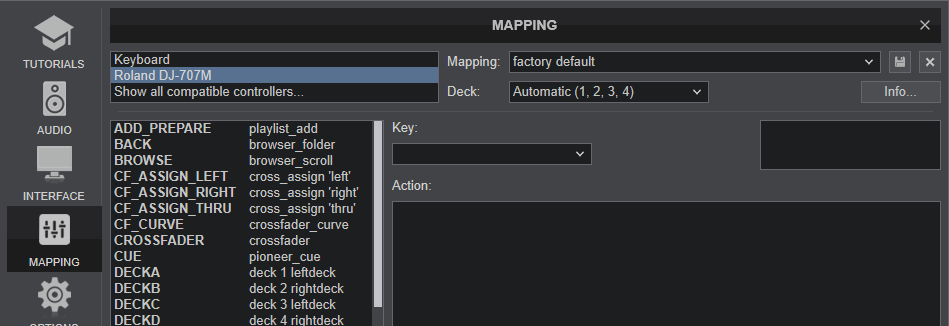
The factory default Mapping offers the functions described in this Manual, however those can be adjusted to your needs via VDJ Script actions.
Find more details at https://www.virtualdj.com/wiki/VDJ8script.html
AUDIO Setup
The unit has a pre-defined Audio setup and a special button in the AUDIO tab of Config to provide that.
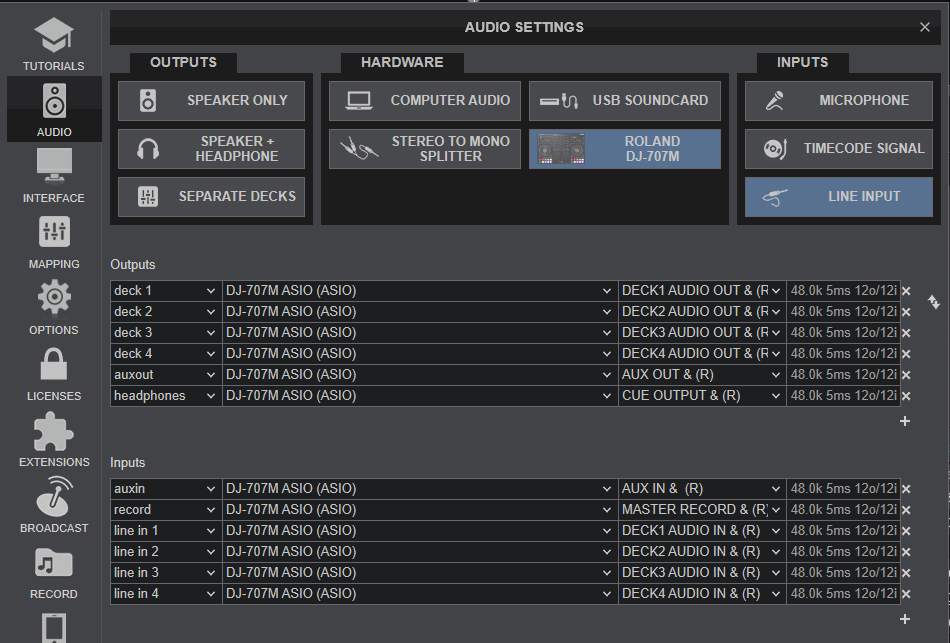
See also Advanced Setup for further Audio settings
For further software settings please refer to the User Guide of VirtualDJ.
https://www.virtualdj.com/manuals/virtualdj8/index.html
LAYOUT

S SHIFT. Hold this button down to access secondary functions of the Roland DJ-707M
The functionality of each button, knob and slider per section (as shown in the image above) will be explained in detail in the following chapters
A Mixer Controls
B Deck Controls
C Performance Pads
D Microphone
E LCD screen & Utilities Menu
F Front & Rear Panels
MIXER CONTRLOLS

- CROSSFADER: Blends audio between the left and right assigned channels.
- VOLUME: Alter the output Volume of each Mixer Channel.
- CUE (CH PFL). Press this button to send this channel's pre-fader signal to the Headphones Channel for monitoring. When engaged, the button will be lit.
Hold SHIFT down and then use the CUE buttons to make the mic section’s effect follow the key information of the song that’s loaded into the deck.
Hold the CUE button down and then use the SELECT (PUSH ENTER) knob at the top right to change the FILTER/FX effect on each mixer channel. - FILTER/FX. Use this knob to apply a hardware Mixer FX (Filter by default, or any other FX selected from the Roland Utilities Menu - see CUE button above) of each mixer channel. When the knob is at the middle position, no Mixer effect is applied. Hardware operation but visible on VirtualDJ GUI
Note that the Filter or any other Color FX of VirtualDJ will not apply to the VirtualDJ decks (fake Filter mode) - * EQ-LOW. Adjust the Low (Bass) frequencies of each mixer channel.
- * EQ-MID. Adjust the Mid (Middle) frequencies of each mixer channel.
- * EQ-HI. Adjust the High (Treble) frequencies of each mixer channel.
- TRIM: Adjusts the pre-fader output level (gain) of each channel mixer.
The VU meters indicate the pre-fader output volume of each channel mixer. - CHANNEL SOURCE: The Source switchers offer the ability to assign a different source to each mixer channel.
- When set to PC, the mixer channel is assigned to a VirtualDJ deck (following the pre-defined order 3-1-2-4). Use this position if you want to use and control a VirtualDJ deck or use a DVS (Timecode)input connected at the rear panel Inputs.
- When set to LINE, the mixer channel is assigned to the external Input (connections at the rear panel) and the corresponding deck is set as Line Input. the signal of the external input will be routed to VirtualDJ and then sent back to the Roland DJ707M output channel
- When channel 3 is set to TR, the audio signal from the Roland TR Sampler will be routed to deck 3 of VirtualDJ as Line Input
- When channel 4 is set to OSC, the audio signal from the Roland Oscillator will be routed to deck 4 of VirtualDJ as Line Input - MASTER VOLUME : Adjusts the Master Output Volume (Hardware operation but visible on VirtualDJ GUI)
The VU meter below this knob indicates the level of the Master Output. - BOOTH VOLUME: Adjust the volume of the Booth Output (connection at the rear panel)
- ZONE VOLUME: Adjust the volume of the Zone Output (connection at the rear panel)
- SAMPLER VOL: Adjust the output Volume of VirtualDJ Sampler.
* Note The EQ section of the mixer is capable of controlling Stems (EZRemix or ModernEQ modes) . See details at EQ Modes
DECK CONTROLS
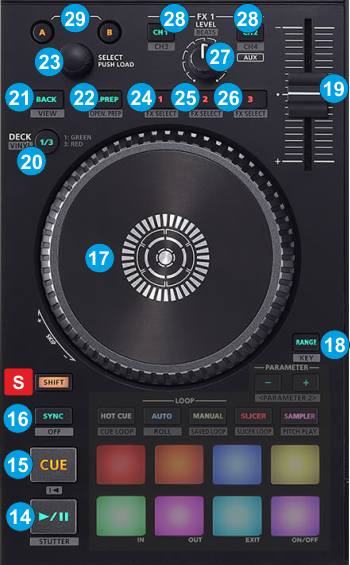
S SHIFT.Hold this button down to access additional functionality for several buttons/knobs as described in this manual.
- PLAY: Play/Pauses the track. Hold SHIFT and then press this button to play the track in Stutter mode (while pressed)
- CUE: When the Deck is paused, you can set a temporary Cue Point by moving the Platter to place the Audio Pointer at the desired location and then pressing the Cue Button. During playback, you can press the Cue Button to return the track to this Cue Point. (If you did not set a Cue Point, then it will return to the beginning of the track.). If the Deck is paused, you can press and hold the Cue Button to play the track from the Temporary Cue Point. Releasing the Cue Button will return the track to the temporary Cue Point and pause it. To continue playback without returning to the Temporary Cue Point, press and hold the Cue Button, then press and hold the Play Button, and then release both buttons.
Hold SHIFT and then press this button to return to the beginning of the track - SYNC: Syncs the deck with the Master Deck. The Master Deck selection is made automatically by VirtualDJ, mostly depending on the Deck that is playing out in Master.
Hold SHIFT and then press this button to manually set a deck as Master Deck and force all other decks to sync to the Master Deck when SYNC is used. To return to the automatic selection, press again the button on the deck that is currently lit. - JOG: Touch sensitive platter for scratching or bending. When in Vinyl mode, use the upper part of the jogwheel to scratch and the outer part to bend. When in Bend mode (Vinyl mode is disabled), use any part of the jogwheel to bend.
Hold SHIFT and use the JOG in Seek (Search) mode. - RANGE: Press this button to select the next available % range for the Pitch fader
Hold SHIFT down and then use this button to enable/disable Master Tempo (Key Lock) and allow the Key of the track to retain its value when in Tempo changes. - PITCH : Pitch fader to adjust the Tempo of the track.
- DECK SELECT: Use these buttons to select a Deck for the left and right side to control. The Left side of the DJ-707M can control decks 1 (button lit in green) or 3 (button lit in red), and the Right side can control decks 2 (button lit in green) or 4 (button lit in red).
Hold SHIFT down and then use this button to toggle between the CD (Bend) and Vinyl (Scratch) modes for the Jogwheel - BACK: Use this button to set focus to the Folders list of Browser. If focus is already in Folders list, use this button to open/close sub-folders.
Hold SHIFT down and then use the BACK button on the left side to cycle though the available Mixer panels of VirtualDJ GUI (Mixer, Video, Scratch and Master)
Hold SHIFT down and then use the BACK button on the right side to cycle focus of the Browser windows (Folders, Songs and Sideview) - PREPARE: Use this button to add the selected track from the Songs Browser list to the Automix list of Sideview
Hold SHIFT down and then use this button to cycle through the available lists of Sideview (Automix, Sidelist, Sampler, Karaoke and Shortcuts) - SELECT/LOAD: Use this knob scroll through files or folders depending on the focused Browser window (Folders, Songs, Sideview).
Push to load the selected track to the deck. If focus is on Folders list, the button will set focus to the Songs list.
EFFECTS
The left and right FX units apply VirtualDJ effects to the Left and Right decks respectively and operate differently depending on the FX Slots layout mode (1 FX or 3 FX slots). The mode can be selected from the VirtualDJ GUI
- FX 1: Use this button to enable/disable the selected effect on the Left/Right deck
Hold SHIFT down and then use this button to select the next available effect - FX 2: Hold this button down and then use the FX LEVEL (27) to adjust the 2nd parameter of the selected effect (if available)
- FX 3: Hold this button down and then use the FX LEVEL (27) to adjust the 3rd parameter of the selected effect (if available)
- FX LEVEL: Use this knob to adjust the 1st parameter of the selected effect. If FX 2 or FX 3 buttons are held down, parameters 2 and 3 can be adjusted using the same knob.
- FX ASSIGN: These buttons are not pre-assigned to any VirtualDJ script action, since the FX units always apply to whatever deck is assigned as Left or Right, and can be customized to your needs.
Single FX mode
- FX 1: Use this button to enable/disable the selected effect of the 1st FX slot on the Left/Right deck
Hold SHIFT down and then use this button to select the next available effect for FX Slot 1 - FX 2: Use this button to enable/disable the selected effect of the 2nd FX slot on the Left/Right deck
Hold SHIFT down and then use this button to select the next available effect for FX Slot 2 - FX 3: Use this button to enable/disable the selected effect of the 3rd FX slot on the Left/Right deck
Hold SHIFT down and then use this button to select the next available effect for FX Slot 3 - FX LEVEL: Use this knob to adjust the 1st parameter of the selected effect of all FX Slots at the same time
Hold SHIFT button down and then use this knob to adjust the 2nd Parameter of the selected effects of all FX Slots - FX ASSIGN: These buttons are not pre-assigned to any VirtualDJ script action, since the FX units always apply to whatever deck is assigned as Left or Right, and can be customized to your needs.
Multi FX mode
DUAL USB - DJ CHANGE-OVER
The Roland DJM-707M offers 2 USB ports at the rear panel, to connect 2 computers running VirtualDJ (or other supported software), making the DJ changeover easy.
- PC A B: Use these buttons to select the USB port (to which a computer is connected at the rear panel) and assign a side of the DJM-707M (left or right) to VirtualDJ (or other supported software).
When only 1 computer is connected to the USB ports (A or B), those buttons have no functionality.
PERFORMANCE PADS
- PAD MODE. Press any of the 5 available Pad mode buttons to set the Pads to Hotcues, Loop , Manual Loop, Slicer or Sampler mode.
Hold SHIFT and then press any of the 6 available Pad mode buttons to set the Pads to Cue Loop, Loop Roll, Saved Loops, Beat Jump and Key Cue mode. All 12 available Pad modes are explained in details in this page.
Note Due to firmware limitation, Split Pages are not offered from the device's Pad mode buttons. - PADS. The 8 Pads offer different functionality depending on the selected mode.
- PARAMETER. Use the (-/+) Parameter buttons to adjust (decrease/increase)the 1st Parameter of the selected Pad mode (if available).
Hold SHIFT and then use the (-/+) Parameter buttons to adjust (decrease/increase)the 2nd Parameter of the selected Pad mode (if available)
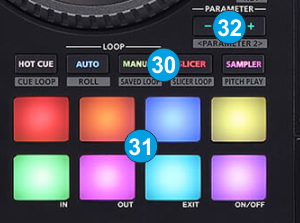
Read further details about Pads in the VirtualDJ 8 manual
HOTCUES
Each one of the 8 pad assigns a Hot Cue Point (1 to 8) or jumps the track to that Hot Cue Point (if assigned).
When a Hot Cue Button is unlit, you can assign a Hot Cue Point by pressing it at the desired point in your track. Once it is assigned, the Hot Cue Button will light on.
The color of the Pad depends on the setting nonColoredPOI or the assigned color from the POI Editor
Hold SHIFT and then press a pad to delete its assigned Hot Cue Point.
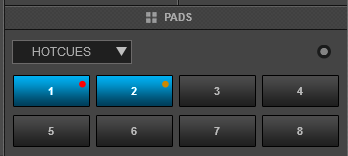
Use the PARAMETER buttons (32) to jump the song to the previous/next assigned HotCue point.
Hold SHIFT and then use the PARAMETER buttons (32) to jump 1 beat backwards/forward
While in HOTCUE mode, press the same HOTCUE mode button again to set the pads to Hotcues 9 to 16 mode (button will be lit in orange) and control Hotcues 9 to 16 the same way as above.
LOOP
Press one of the pads to trigger an Auto Loop of a different size in beats, depending on the selected page. There are 6 different pages available with sizes starting from 1/32 up to 128 beats.
Use the PARAMETER buttons to select the previous/next page with the desired Loop sizes
Hold SHIFT and then use the PARAMETER buttons to change the behavior of the Loop pads, by selecting the On/Off (toggle), Hold (momentary – while pad is pressed) or the Roll mode (track will resume to the position it would have been once the pad is released)

MANUAL LOOP
Press one of the pads to trigger an Auto Loop of a different size in beats, depending on the selected page. There are 6 different pages available with sizes starting from 1/32 up to 128 beats.
Use the PARAMETER buttons to select the previous/next page with the desired Loop sizes
Hold SHIFT and then use the PARAMETER buttons to change the behavior of the Loop pads, by selecting the On/Off (toggle), Hold (momentary – while pad is pressed) or the Roll mode (track will resume to the position it would have been once the pad is released)
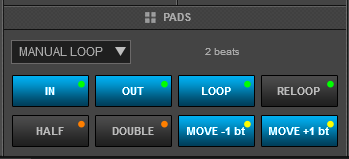
SLICER
The 8 pads represent eight sequential beats—"Slices"—in the Beat Grid. The currently playing Slice is represented by the currently green lit pad. The light will move through the pads as it progresses through each eight-Slice phrase. Press a pad to repeat that Slice (hold it down if you want to keep looping it).
Once the Pad is released the track will continue to play from the position it would have been if the pad was never pressed.
Hold SHIFT and then use the Pads to repeat the memorized Slices (the Slices played/repeated last time)
Use the PARAMETER buttons to adjust the length of the Loop applied to the slice. Hold SHIFT down and then use the PARAMETER buttons to adjust the step of the Slices
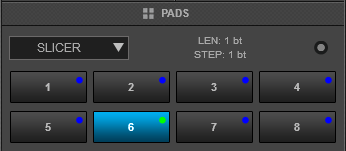
SAMPLER & SAMPLER VELOCITY
Each one of the 8 pads triggers a sample from the selected Sampler Bank of VirtualDJ. If a bank has less than 9 samples, both sides of the DJ-707M will control the same samples. If a bank has more than 8 samples, the left side of the DJ-707M will control samples 1 to 8 and the right side samples 9 to 16. The PAD will be lit with a faded color if a sample slot is loaded and with the same color bright if triggered.
Press the pads to trigger a sample. Depending on the selected trigger Pad mode, use SHIFT and the same pads to stop the sample.
Use the PARAMETER buttons to select the Sampler Bank (previous/next).
Hold SHIFT down and then the PARAMETER buttons to select the Trigger Pad mode (on/off, hold, stutter, unmute)
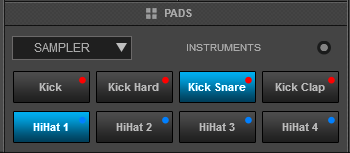
While the Sampler mode is selected (led is lit in violet), press the SAMPLER mode button again to set the PADs to Sampler Velocity mode (button will be lit in magenta) and automatically load the Sampler Pads page in VirtualDJ GUI
Same as in the Sampler mode, the Pads trigger a Sample from the selected Sampler Bank of VirtualDJ, but at the same time the output volume of each sample is controlled by the pressure applied on the Pad
CUE LOOP
In this mode each one of the 8 pads assigns a Hot Cue Point or jumps the track to that Hot Cue Point, but in both cases, it also triggers a Loop at that point (momentary or toggle depending on the selected mode from the Page menu).
Hold SHIFT and then press a pad to stutter/jump to the Hotcue (loop will remain triggered)
Use the PARAMETER buttons to half/double the size of the triggered Loop.
Hold SHIFT and then use the PARAMETER buttons to select the On/Off (Toggle) or Hold (momentary) Loop trigger mode.
By default the Cue Loops will be quantized. This can be turned off/on from the Page Menu on the GUI..
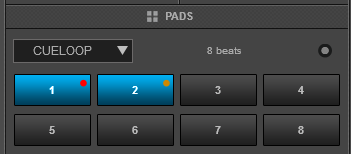
ROLL
Press one of the 8 pads to trigger a momentary Loop Roll. Once the Pad is released, the track will resume playing from the position it would have been if the Loop Roll was never triggered. The exit point will be visible on the waveform of the VirtualDJ GUI with an additional “running” play marker.
Hold SHIFT to get a ½, ¾, 1 and 2 beats Loop Roll sizes for the 4 low pads.
Use the Page menu to apply the Loop Rolls to Video.
The PARAMETER buttons don't have any functionality in this mode.
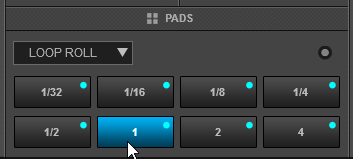
SAVED LOOPS
Each one of the 8 pad represents a slot to save and recall a loop. Press a Pad to save (and trigger at the same time - if not already) a Loop at the current position. Hold the same Pad down for more than 2 seconds to delete the saved loop from the slot.
When a Loop is saved to a slot, use the same Pad to load* (enable) the saved loop, but not jump to its position if the loop is saved to a later position than the current one (load and prepare).
Hold SHIFT and then use the same Pad to load* (enable) the saved loop, and jump to its position.
*Note that only 1 Loop can be enabled each time.
Use the PARAMETER buttons (32) to half/double the size of the Loop.
Hold SHIFT and then use the PARAMETER buttons (32) to move the Loop back/forth in time by 1 beat steps..

BEATJUMP
In this mode, the 8 Pads will jump the track backwards/forward by the amount of beats depending on the selected Beatjump page (from 1/8 beats to 32 Bars)
Use the PARAMETER buttons to select the previous/next Beatjump bank page
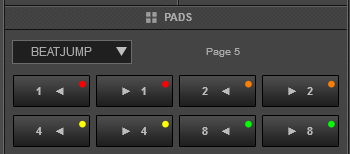
Key-Cue mode
Hold SHIFT and then press the SAMPLER Mode button to set the Pads to Key-Cue mode (the led of the SAMPLER button will be lit in green color). The KeyCue page will be then selected and displayed in the Pads section of the VirtualDJ skins.
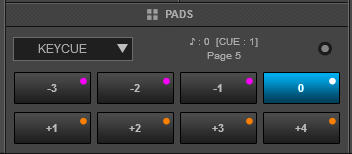
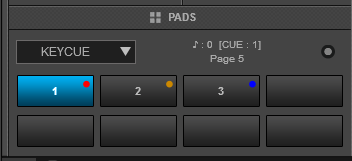
In this mode, the Pads trigger a selected Hotcue point (or the Temporary Cue if none selected or not available) at a selected Key semitone (from -7 to +7).
8 different pages/banks are offered with various semitone values to use and a 0 value (reset key to tis original value) is always offered in all pages.
Hold SHIFT and then select a Hotcue for the Key pads to trigger. Each time a Pad is pressed, the track will jump to that Hotcue point and will also alter the Key of the track to the value designated by it assigned value.
Use PARAMETER buttons -/+ to adjust the Key of the track without trigger a Hotcue.
Hold SHIFT and then use the PARAMETER buttons to select a different page/bank with different key semitone values.
TR - PERFORMANCE PADS
When mixer Channel 3 is set to TR and left side of the DJ-707M is set to Deck 3, the Performance Pads offer functionality for the TR Sampler and not a VirtualDJ Pads page. See further details in TR Sampler chapter
OSC - PERFORMANCE PADS
When mixer Channel 4 is set to OSC and right side of the DJ-707M is set to Deck 4, the Performance Pads offer functionality for the DJ-707M Oscillator and not a VirtualDJ Pads page. In this case, only the SAMPLER mode button is available.
Each one of the 8 Pads plays a sound effect while Pad is held down. Press the SAMPLER mode button again to select the Velocity mode and play the same sound effects at a volume depending on the pressure applied to the Pad
MICROPHONE CONTROLS
The Roland DJ-707M offers 2* Microphone Inputs (connections at the rear panel) and can be controlled from the top-left panel.

- MIC ON 1/2: Use these buttons to turn the Microphone Inputs On/Off.
- DUCK: Use this button to turn on/off ducking (an effect that lowers the output volume of sounds other than the mic when mic input is present) for mic 1 and 2.
Hold this button down and then use the [SELECT (ENTER)] knob to adjust the output level when ducking is on. This adjusts the MASTER/BOOTH/ZONE levels simultaneously. - MIC FX: Use this button to turn on/off the vocal effect for mic 1 and 2. You can change the vocal effect in Scene Edit (from the Roland DJ-707M Utilities menu)
- MIC LEVEL: Use these knobs to adjust the output volume of the microphone Inputs 1 and 2
- MIC EQ (HIGH/MID/LOW): Use these knobs to boost/cut the volume of the high-frequency, mid-frequency, and low frequency regions of the 2 Microphone inputs
- MIC VOCAL FX Use these knobs to adjust the depth of the applied vocal effect of the Microphone inputs 1 and 2.
*Note: An additional Microphone input can be assigned to the AUX Input (front panel)
LCD SCREEN & UTILITIES MENU

- LCD SCREEN: The LCD screen will display the options of the Utilities menu. when not in the Utilities the screen will display the BPM values of the 4 mixer channels (could be the value from a VirtualDJ deck, TR Sampler or a Live Input) .
- MENU NAVIGATION: Press the MENU button to enter the Roland DJ-707M Utilities menu and then use the SELECT knob and the BACK button to navigate and adjust various options. For further details, read the Roland DJ-707M Owner's Manual from https://www.roland.com/global/products/dj-707m/support/
One of the frequently used settings that you may need from the Utilities, is the ability to send a mixer channel to the Zone Output. The Roland DJ707M offers the following modes.
1: Standard The same audio as MASTER OUT is output from ZONE OUT. This allows the same use as a standard DJ controller.
2: Two-Room: Mic audio is not output from ZONE OUT. This is useful when you want to output only the song audio to a
different venue than the main venue.
3: DECK4-ZONE :The deck 4 audio is output only from ZONE OUT, without being mixed into MASTER OUT or BOOTH OUT.
This is useful when you want to output different music to the main venue and to another venue.
4: MICs-ZONE The mic audio is output only from ZONE OUT. This is useful when you want the mic audio to be output from different speakers.
5: SoundBoost A multi-band compressor is applied to each output. This makes mixing easier when using TR, etc.
- Press the MENU button
- Rotate the SELECT knob to get the Scene Load option from the MENU.
- Push the SELECT knob to select the Scene Load.
- Rotate the SELECT knob to get the DECK4-ZONE option. Push to load
- Push the SELECT knob again (OK) to confirm.
- Press the EXIT button to exit the Menu.
With the above, you can now use the mixer channel CH4 (Deck 4 of VirtualDJ) to send different audio from what is sent to Master and Booth Outputs.
FRONT & REAR PANELS

- PHONES INPUT: Connect a pair of Headphones to one of the available sockets, using 1/4" or 1/8 " cable/connector for prelistening.
- PHONES LEVEL: Adjust the output volume of the Headphones channel (Hardware operation)
- PHONES LEVEL: Use this knob to blend in Headphones the audio signal from the Master Output and the Decks that are sent to Headphones Channel via the CUE/PFL buttons. (Hardware operation, not visible on the VirtualDJ GUI). When the knob is at the minimum position, only the Decks that have been selected with the CUE/PFL buttons (at the top panel) will be heard in Headphones. When the same knob is at the maximum (right) position, the signal from the Master Output will be heard in Headphones.
- PHONES SPLIT: When this switch is in the SPLIT position, the headphone audio will be "split" such that all channels sent to Cue are mixed to mono and applied to the left headphone channel and the Program mix is mixed to mono and applied to the right channel. When the switch is in the STEREO position, Cue and Program audio will be "blended" together.
- CROSSFADER CH ASSIGN: Routes the audio playing on the corresponding channel 1 to 4 to either side of the crossfader (A or B), or bypasses the crossfader and sends the audio directly to the Program Mix (center, THRU).
- CROSSFADER CURVE. Adjust the response curve of the cross fader.
- AUX IN MIC/MONO/STEREO: Select the AUX IN source, depending on the connected device.
Set to MIC If a mic is connected.
Set to MONO If you want to input sound in mono.
Set to STEREO If you want to input sound in stereo. - AUX IN LEVEL: Adjusts the level of the sound that’s input to the AUX IN jacks.
- AUX IN SOCKET: Connect these sockets to a mic or audio device.

- MIC IN 1/2 Connect your microphones here using 3-PIN XLR cables/adapters
- INPUT (CH 1–CH 4) These jacks input sound to channels 1–4. The CH 1 and C H2 INPUT jacks support phono input from MM-type cartridges. Set the input select switch of the mixer section appropriately for the device you’re connecting.
- MASTER OUT Connect your powered speakers or power amp here. Both XLR type and RCA phono type plugs are supported. The level of this output is controlled by the MASTER LEVEL knob at the top panel
- BOOTH OUT These are the output jacks for booth monitoring.. The level of this output is controlled by the BOOTH LEVEL knob at the top panel
- ZONE OUT Use these output jacks when you want to send signals to another location independently from MASTER OUT or BOOTH OUT. Connect them to your speakers or recorder.. Use the Utilities Menu of the Roland DJ-707M to define what will be routed to the Zone Output. The level of this output is controlled by the BOOTH LEVEL knob at the top panel
- MIDI OUT This connection outputs MIDI messages such as MIDI clock.
- USB Use any of the 2 available USB connections to sends and receives audio and control information from a connected computer.
- POWER: Use the included power adaptor to connect DJ-707M to a power outlet. Use the Power Switch to turn the unit on and off. Turn on DJ-707M after all input devices have been connected and before you turn on amplifiers. Turn off amplifiers before you turn off the DJ-707M
TR SAMPLER
When mixer Channel is set to TR and Deck 3 is assigned on the left deck side, you can play “patterns” created using drum sounds (instruments) such as those of a Roland TR-808 rhythm machine.
What are patterns?
“Patterns” contain performance data for instruments. Sixteen patterns are provided. Each pattern has eight “variations,” and when you select a pattern, the variations are automatically assigned to performance pads 1–8.
Playing Patterns
Preparation
1. Set the mixer section CH3 input select switch to “TR.”
2. In the left deck, press the DECK [1/3] button to make it light red.
Selecting a pattern
Turn the [SELECT (ENTER)] knob to select a pattern (01–16), and press the knob to confirm.
The variations of the selected pattern are assigned to performance pads 1–8.
Playing back a pattern
1. Press a performance pad 1–8 to select a variation. The pad you pressed blinks. You can select multiple variations by holding down a pad and pressing another pad.
2. Press the PLAY button. The variation starts playing. If you selected multiple variations, the variation whose pad is blinking
plays, and then the other variations play consecutively starting with the lowest-numbered variation.
If you select the next variation during playback, the pad you press blinks.
If you hold down the SHIFT button and press a pad, the variation of the pad that you press is reserved. When the currently-playing variation finishes playing, playback automatically switches to the reserved variation.
Syncing a TR pattern with another Deck
When the SYNC button is unlit, the TR Sampler plays at the Tempo designated by the Pitch fader (100 BPM when in center). Use the Tempo slider to adjust its Tempo. Its value will be displayed at the LCD screen (as Deck 4).
Press the SYNC button to synchronize BPM and Beat Phase (CBG) with the current Master Deck of VirtualDJ. Note that VirtualDJ will automatically assign a Deck as Master, mostly depending on which one is playing out live. You can use SHIFT+SYNC on a VirtualDJ Deck (or use the MASTER buttons from the GUI) to manually set a Deck as Master Deck (and sync all other decks including TR to that deck). Repeat this procedure to revert to the automatic Master Deck assignment.
When the SYNC button on the TR is lit, the Tempo slider will not alter its Tempo and will follow the one from the Master Deck.
Hold SHIFT and then press the SYNC button to turn off synchronization and revert to manual Tempo adjustment.
TR - Performance Pads
When mixer Channel 3 is set to TR and the left side of the DJ-707M is set to Deck 3, the performance Pads offer functionality for the TR Sampler, depending on the selected mode.
HOTCUES
In this mode each pad plays the variation at the moment you press the pad.
By holding down a pad and successively pressing other pads, you can play multiple variations consecutively.
Hold SHIFT and then press a Pad to reserve its variation. When the currently-playing variation finishes playing, playback automatically switches to the reserved variation.
AUTO
Starts looping at the moment you press a pad. Looping occurs at the beat (1/64, 1/32, 1/16, 1/8, 1/4, 1/2, 1, 2) that’s assigned to each pad.
Use the PARAMETER (-/+) buttons to halve or double the loop.
ROLL
Enter Roll mode by pressing SHIFT and AUTO mode button. In this mode each pad plays the loop only while you hold down the pad. When you take your finger off the pad, you return to the original position.
Looping occurs at the beat (1/64, 1/32, 1/16, 1/8, 1/4, 1/2, 1) that’s assigned to each pad.
Use the PARAMETER (-/+) buttons to halve or double the loop.
MANUAL LOOP
Enter Manual loop mode by pressing the MANUAL mode button. In this mode Loop-plays between the specified loop-in and loop-out.
Use Pads 1 to 4 to selects a loop slot.
Use Pad 5 to specify the loop-in point.
Use Pad 6 to specify the loop-out point.
Use Pads 7/8 to turns loop on/off.
SLICER
Enter Slicer mode by pressing the SLICER mode button. In this mode Loop-plays the beat at the moment you pressed the pad.
When you take your finger off the pad, you return to the original position.
Use the PARAMETER [–] [+] buttons to halve or double the loop.
Hold down SHIFT and then use the PARAMETER [–] [+] buttons to halve or double the beat that’s looping.
SAMPLER
Enter Sampler mode by pressing the SAMPLER mode button. In this mode each Pad plays the instrument that’s assigned to.
Hold SHIFT down and then press the SAMPLER mode button again to enter the Velocity mode, in which each Pad plays the instrument with velocity.
Hold SHIFT down and then press a Pad 1 to 8, to mute or un-mute each instrument. If muted, the pad is unlit.
ADVANCED SETUP
RECORDING
The Roland DJ-707M offers a dedicated Record Input which allows you to record your mix including audio signal from VirtualDJ decks, analog inputs (connected to CH1 to CH4) and both Microphone inputs.
This Record input is part of the default audio configuration, so there is nothing to be done for recording your mix except to press the REC button in the MASTER mixer panel of VirtualDJ GUI.
MICROPHONES
The Roland DJ-707M offers 2 Microphone Inputs at the rear panel and both are routed directly into the Master/Booth Outputs. These inputs are not part of the USB Audio interface, therefore cannot be added to the Audio setup of VirtualDJ, neither can be controlled from it.
The signal of the Microphone Inputs is also included in the special Record Input, so its signal is properly recorded along with your mix from VirtualDJ,
TIMECODE (DVS)
The audio interface of the Roland DJ-707M offers 4 stereo inputs, that can be used as Timecode Inputs (DVS)*.
- Connect your DVS unit (CD player with Timecode CD or turntable with Timecode Vinyl) to the appropriate INPUT at the rear panel.
IMPORTANT NOTE : The Inputs of CH1 and CH2 can be used with Timecode Vinyl, while the Inputs of CH3 and CH4 can be used for Timecode CD. - Make sure you have the INPUT SELECT at the top panel of this channel set to PC.
- Click on the TIMECODE SIGNAL button in the Audio Setup of VirtualDJ to add the Timecode inputs.
- Delete (with the x button next to each line) the timecode inputs that you don't use
- Press APPLY
- Start playing your Timecode devices and then visit the TIMECODE tab of VirtualDJ Settings to Calibrate your Timecode signal. The calibration will be saved and will not be necessary next time you connect the same Timecode sources.
- From the SCRATCH panel of VirtualDJ GUI, use the ON buttons to select on which VirtualDJ deck your Timecode signal will apply to
In the following example we are using all 4 Inputs, with CH1 and CH2 mixer channels with Timecode Vinyls and CH3 and CH4 mixer channels with Timecode CDs
Note that the linein inputs are still part of the Audio Setup.
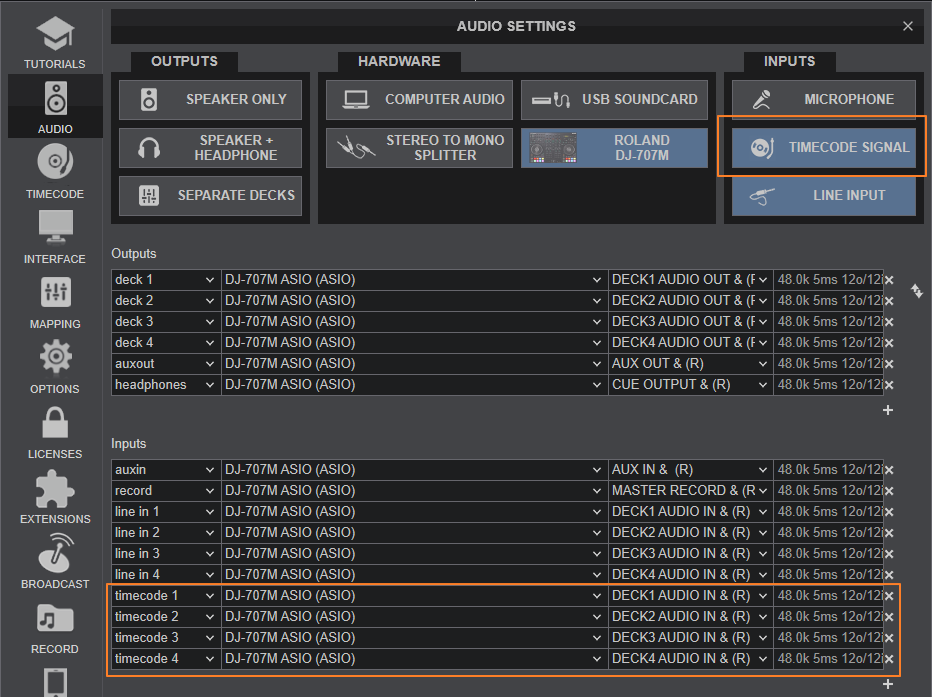
*Note : Line Inputs and Timecode (DVS) require a Pro Infinity or a Pro Subscription license
